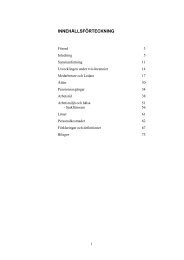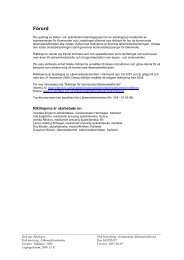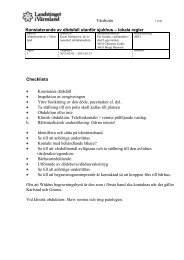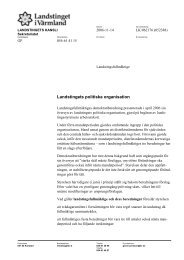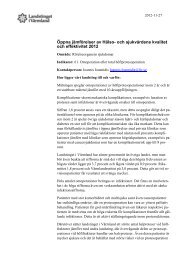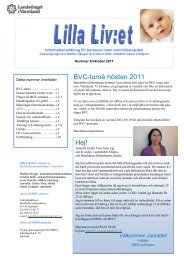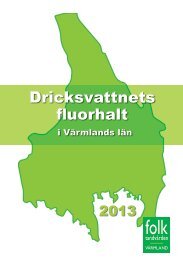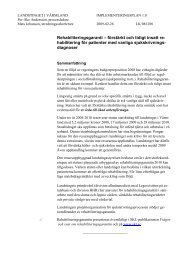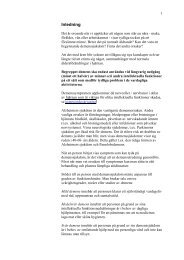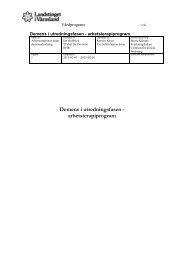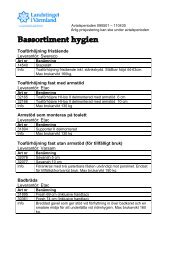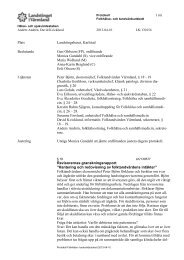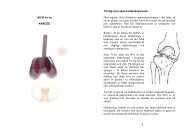Severs skada – paradigmskifte gällande diagnostik och behandling?
Severs skada – paradigmskifte gällande diagnostik och behandling?
Severs skada – paradigmskifte gällande diagnostik och behandling?
Create successful ePaper yourself
Turn your PDF publications into a flip-book with our unique Google optimized e-Paper software.
Perhamre et al.<br />
Table 4. Pain level measured with Borgs CR-10 scale<br />
unusual, are two reasons to question these treatment<br />
strategies in Sever’s injury. The golden age of tissue<br />
development peaks at 11<strong>–</strong>12 years. The physiological<br />
remodelling to develop strong and lasting tissues<br />
with enough capacity to resist injuries (Wolff’s law)<br />
requires physical activity with repeated impact force<br />
to the hind foot. This relation between stimulating<br />
load and developing capacity seems to be disturbed<br />
in Sever’s injury. Histological analysis of the region<br />
shows a primary compression, rather than a tension<br />
cytoarchitecture (Ogden, 2000). The heel pad with its<br />
sum of cooperating compartments provides cushioning,<br />
and thereby reduces the impact force on calcaneus<br />
in heel strike (Ogden, 2000). An effective<br />
support to the heel pad therefore seems to be crucial,<br />
and this is supported by the findings in our previous<br />
study were the heel cup was shown to be superior to<br />
the wedge in giving pain relief (Perhamre et al.,<br />
2010a).<br />
Soccer is the predominating sport among our<br />
patients. Walter & Ng(2002) showed that the studded<br />
soccer shoe placed the foot in a dorsiflexed position,<br />
increasing the amount of pull from the Achilles<br />
tendon, exceeding the pressure placed upon the<br />
calcaneal apophysis. The conclusions from our previous<br />
studies are that pain in Sever’s injury primarily<br />
is an effect of impact, not shear forces. The reason<br />
why soccer dominates is probably simply because it is<br />
the dominating sport in this age, including both<br />
genders. It includes much running and jumping and<br />
the shoes offer little heel support.<br />
Our two previous studies have shown immediate<br />
and lasting pain relief with the heel cup, confirmed in<br />
the present study (Perhamre et al., 2010a, b). The<br />
purpose with this study was to assess the possible<br />
mechanisms behind the rapid and impressive pain<br />
relief. There was a significant increase of heel cup<br />
thickness from barefoot to shoe and from shoe to<br />
heel cup (Table 1, Fig. 3). There was also a significant<br />
reduction of the heel peak pressure using heel cups<br />
(Fig. 4). We believe that both these effects strongly<br />
support Ogden’s theory that Sever’s injury is a<br />
traumatic condition due to repetitive impact forces<br />
during heel strike with corresponding pathology in<br />
52<br />
Pain at start (median values) Pain at 4 weeks (median values)<br />
Shoes only With cup Shoes only With cup<br />
Group I (treatment) 7.0 2.0 3.0 0.5<br />
Group II (no treatment) 7.0 <strong>–</strong> 5.0 <strong>–</strong><br />
6<br />
the rear foot (Ogden et al., 2004). An effective<br />
treatment seems to reduce these forces. The cup<br />
seems to protect the heel, significantly reducing<br />
pain, compared with our non-treatment group (Table<br />
3). The sample in the peak pressure test was small<br />
(n 5 10) with one child missing in the running trials.<br />
This reduces the power of our conclusions. An<br />
interesting finding was that children with Sever’s<br />
injury show a tendency toward thinner heel pads<br />
compared with the painless control group (Table 2).<br />
This could possibly be a predisposing factor to<br />
Sever’s injury.<br />
Perspectives<br />
Sever’s injury seems to be a result of high impact<br />
forces during an intense puberty period with an<br />
immature heel. The traditional recommendation to<br />
stop or diminish the sports activity for an unspecified<br />
period of time seems inappropriate and we suggest<br />
that this should be replaced by the general advice to<br />
use heel cups and continue with the activities. The<br />
effect of using the rigid heel cup can be explained<br />
both by less deformation, preserving the heel pad<br />
thickness when loaded, and by the reduction of heel<br />
pad peak pressure during heel strike.<br />
Key words: Sever’s injury, apophysitis calcanei, insoles,<br />
heel cup, heel pad thickness, heel peak pressure.<br />
Acknowledgements<br />
Thanks to Ingemar Hansson, who made the heel cups, Klara<br />
Perhamre for help with the figure layout, Mikael Hasselgren,<br />
PhD, medical chief Centre for Clinical Science, Eva Stjernstro¨<br />
m RPT, division chief Va¨ rmland County Council for<br />
support and Ola Wessmark, former chief doctor at our Clinic,<br />
who made the prototype of this heel cup.<br />
Financial support was provided by the Primary Care<br />
Research Unit, by the division Health, Habilitation and<br />
Rehabilitation, the foundation for Orthopaedic Devices,<br />
Va¨ rmland County Council, O¨ rebro University Hospital Research<br />
Committee and Swedish National Centre for Research<br />
in Sports.



